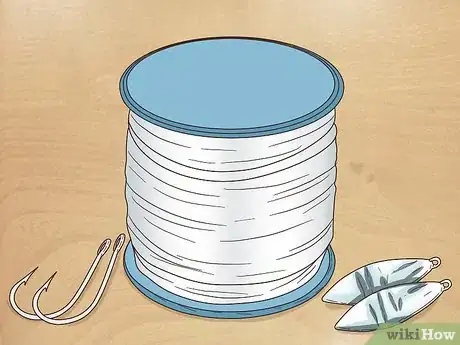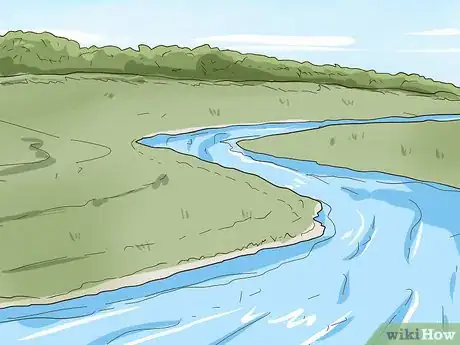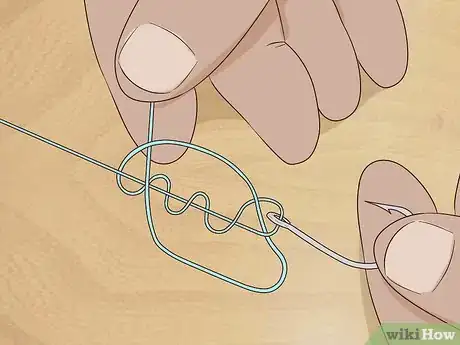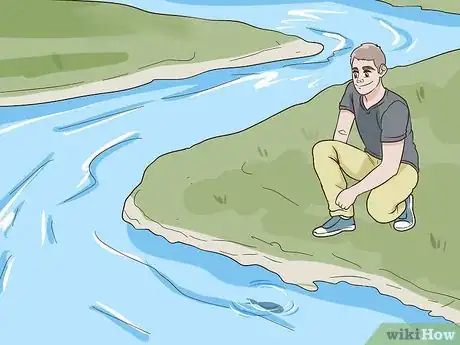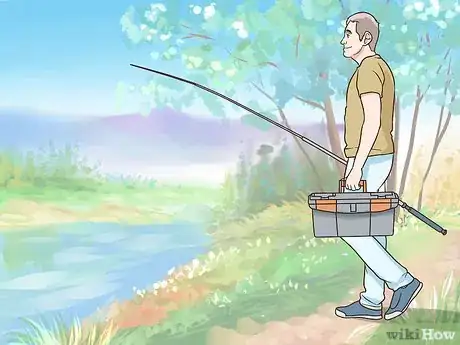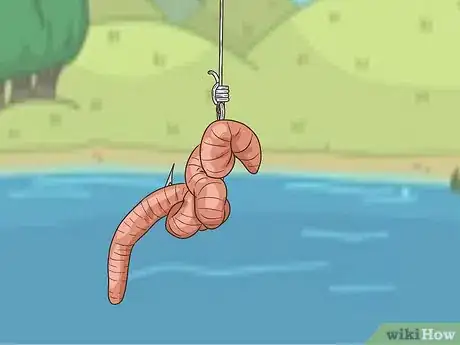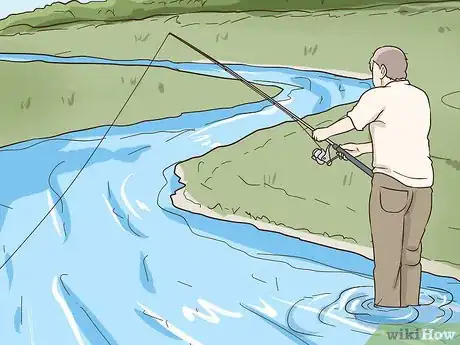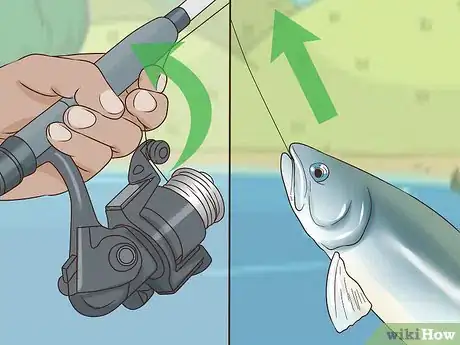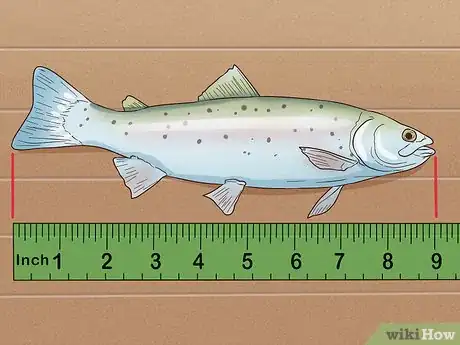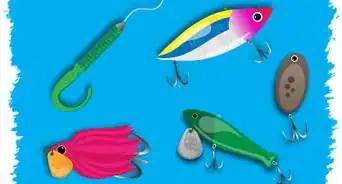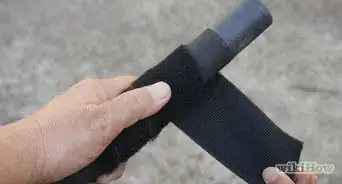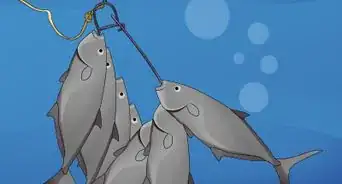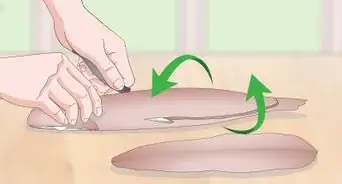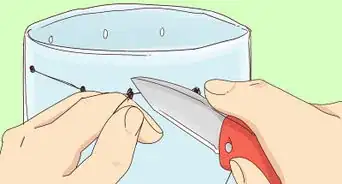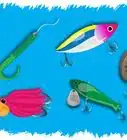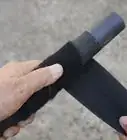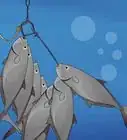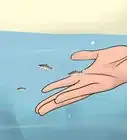This article was co-authored by wikiHow Staff. Our trained team of editors and researchers validate articles for accuracy and comprehensiveness. wikiHow's Content Management Team carefully monitors the work from our editorial staff to ensure that each article is backed by trusted research and meets our high quality standards.
There are 8 references cited in this article, which can be found at the bottom of the page.
wikiHow marks an article as reader-approved once it receives enough positive feedback. This article received 15 testimonials and 92% of readers who voted found it helpful, earning it our reader-approved status.
This article has been viewed 1,089,987 times.
Learn more...
Fishing can seem like a difficult past-time for you to get into because of the different varieties of fishing and all of the equipment. You can buy all the equipment for a relatively cheap price and it's easy to use. Fishing for trout in a river or lake is very peaceful and enjoyable. Get all the equipment, set it up, and head to your nearest lake or river as soon as you can to catch some trout.
Steps
Preparing for Fishing
-
1Find out the rules and regulations regarding catching trout. In most places, trout fishing is regulated in a number of ways. Fish populations and freshwater ecosystems need to be protected from harmful practices. Contact your local wildlife management department to find the trout fishing rules in your area.[1]
- A fishing license is required in most cases to permit you to fish for trout. You might be able to buy a fishing license at your local sports store.
-
2Purchase an open-faced reel if you have fishing experience. Open-faced reels are a little harder to use but work better for spinning and other types of fishing. Open-faced reels can be easily manipulated and allow you greater control over the fishing line.[2]
- A locking mechanism prevents the handle from reversing while the fish is pulling on the line.
- You can find good rod and reel combinations for around $20.
- The fishing pole will have the weight range of the line printed on it. You need to buy a rod that can carry a weight of between 2–8 pounds (0.91–3.63 kg).
Advertisement -
3Get a closed-faced reel if you're new to fishing. Closed-faced reels are easy to use and are great for bait fishing. However, they are also prone to tangling. Tangling can easily frustrate people new to fishing and turn them away from the sport. Many fishermen won't use a closed-faced reel because of how difficult they can be to untangle.[3]
- Good quality rods and reels can be bought for $20 or so.
- Select a rod that is designed to carry a weight of between 2–8 pounds (0.91–3.63 kg) for catching trout.
-
4Purchase hooks, lines, and weights at the fishing store. Fishing is a sport that requires a lot of different equipment. However, you don't need to spend loads of money to get this equipment. Hooks, lines, and weights can be bought for a relatively cheap price.[4]
- If fishing is a passion of yours, buy more expensive equipment that will last you much longer than cheaper counterparts.
- The rod and reel may come pre-spooled with line. Check the line to make sure it can withstand its rated strength. If not, you will have to buy 4–8 lb (1.8–3.6 kg) test fishing line and spool the line onto the reel. Many sporting goods stores have top quality line in bulk, and can spool it for you at a very reasonable cost.
- You will also need #6 to #10 hooks, "split shot" weights, and a net. Split shot weights are small, round pieces of metal that are used to set the float.[5]
-
5Buy earthworms, salmon roe, or corn kernels at your local fishing store. Check regulations to see what bait is allowed. Earthworms, salmon roe, and corn kernels are the most popular types of bait. Find out before you buy if any of these baits are banned by the local authorities.[6]
- If you are fishing in a small river, use lighter lures. An exception to this is small, fast-moving rivers. These waters require heavier lures. Fast moving rivers are more powerful and you'll need a stronger rod here. Small rivers and streams don't put as much pressure on the rod, so you can use a lighter lure.
Setting up Your Equipment
-
1Find a river or lake with cool and clean water. Trout are a very common fish. They can be easily found in water that is cool and clean. Water with plenty of aquatic insects and protection from predators will also be full of trout. You can find trout in still waters like lakes and ponds or in moving waters such as rivers and streams.[7]
-
2Rig up your equipment before departing. The easiest thing to do is to tie on a barrel swivel using a simple clinch knot. Under no circumstance should an overhand knot be used. This will cause the monofilament line to cut itself. Try tying one of these knots in the line and give it a quick jerk if you would like to see how harmful this knot is.[8]
- To tie a clinch knot, thread the end of your fishing line through the eye of the hook. Then double back and twist the line around the standing line. Twist the line 6 or more times around the standing line. Bring the end of the line back the first loop behind the eye and then through the bigger loop. Lightly soak the knot and slide it tight against the hook. Clip the excess line with scissors and close the knot.
- To set up a pole with no line on it, pull the line through the holes on the rod. When you get to the reel, thread the line through the line guide, which is located at the front of the reel. Wrap the line around the reel and tie 2 knots to keep the line secure. Cut off any excess line with scissors. Flick the reel handle and the line will move down and onto the reel. Continue reeling the line in until it's tightly wound around the reel.
-
3Attach split shot weights to the line. This serves 2 purposes. It allows you to cast your line more effectively and it allows you to control how fast your bait will drift in the water. Place the weights about 2 feet (0.61 m) below the hook. Make sure you pinch them hard enough so they won't move on the line, but loose enough that you can adjust their position.
- Use 3 weights at first and remove or add weights depending on how fast your bait is moving.
Fishing for Trout
-
1Fish during the morning or evening when the weather is fair. Fish will bite in almost any condition, but you should at least attempt to remain dry, so wait for good weather. If you don't mind fishing in bad weather, you can match your bait to the weather conditions. During a rainstorm and up to 24 hours afterward, many earthworms will be washed into the river. This is the best time to fish for worms.[9]
- The best time of the day to fish for trout is early in the morning and late in the evening. Trout do not like bright light. They will be more likely to come closer to the surface to feed when the light is less intense.
- On windy days baits like grasshoppers or crickets are effective. This is due to the fact that windy conditions cause these bugs to end up in the water.
-
2Scout the river or lake when you arrive for a fishing spot. Leave all of your fishing stuff in the car. Look for other fishermen along the shoreline. Look for any nice clearings on the shoreline that are easily accessible. You'll also want to look for slow moving patches of deep water, or any area where the water goes from deep to shallow or shallow to deep.[10]
- Converging currents are another good thing to look for as fish will be drawn into these converging areas. If it's a stocked river or lake, there should be plenty of people fishing.
- If you're inexperienced, don't be afraid to talk to other fishermen. They'll more than likely be happy to show you the ropes.
-
3Get your fishing gear and head to your scouted spot. You rigged up all the equipment at home so now all you have to do is set it up at the lake or river. Be careful wading into the water as you might lose your footing at any point. Don't wade too deep into the water.[11]
-
4Attach your bait to your hook. If you are using one of the worms, you need to push the hook through the end of the worm. Work the length of the worm onto the hook until the worm gets to the end of the hook, then pull the tip of the hook out through the worm to expose it. Pinch off the remainder of the worm about 1 inch (2.5 cm) away from the hook so that a small part dangles from the end.[12]
- If you are using the Roe or the corn, simply push a couple of pieces onto the hook just past the barb.
-
5Cast the fishing line slightly upstream or into the current. A good rule of thumb for trying to catch visible fish is to go 20–50 feet (6.1–15.2 m) downstream and cast upstream past the fish. This serves two purposes. As stated earlier, you need to have a lifelike drift on your bait or lure. That means that if you go downstream you are behind them and less likely to be seen.[13]
- To cast the rod, bring the rod tip behind you slowly. Press and hold the button on the reel with your thumb. Quickly bring the rod tip directly in front of you and release the button in the middle of the cast. Be careful not to whip the rod too hard or your bait will get thrown off the hook.
- If using a rod without a button, use your index finger to hold the line, then flip the bail (the little bar) up and continue to hold the line. Follow the same instructions as above, by holding on until the middle and letting it fly.
- You can cast from the shore of the lake or river or you can wade into the water. You'll probably have more success catching trout if you wade into the water. However, your movements might also scare them away.
-
6Let the bait drift, keeping the rod tip up and about face level. Once the bait gets past you, the line will start to tighten up, so keep your eyes on the rod tip and where the line is going in your peripheral vision. Any small pulls on the rod tip could be the bait bouncing off rocks or it could be a trout tasting the bait. Wait for the trout to take the bait.
- You will feel a big pull on the rod when you have a fish on the line.
-
7Set the hook when you've got a bite. Do this by quickly jerking the rod tip up 1–2 feet (0.3–0.6 m). If you've hooked the fish, your rod will be heavily bent over. Reel in slowly and keep the rod tip above your head. If you lower the rod tip, the fish can get off the hook as it violently thrashes about in the water. Once you have the fish reeled into shore, take your net and gently scoop it up.[14]
-
8Keep the trout if you want to cook it later. You need to know the regulations on what size fish you are allowed to keep. Stocked fish are usually about 9 inches (22.9 cm) long if stocked small. These are too small to fillet but are delicious when prepared whole.[15]
- Only keep the trout if you will eat it.
- Stocked fish rarely survive over winter or reproduce, and compete with wild fish.
- If you do not fillet the fish you will need to clean it (remove its innards) before cooking it.
-
9Protect the fish if you decide to release it. If you do not wish to keep the fish, it is very important that you not handle the fish at all if possible. Wet your hands and net before handling the fish. Try to keep the fish in the water and grasp the hook at the curve, either with your fingers or forceps, and gently remove it from the fish.[16]
- Trout, like all fish, have a protective coating of slime on them. Touching them removes the slime and will actually "burn" the fish where you touch it. Use a net to return the fish to the water.
- If the fish swallowed the hook, you will have to cut the line and try not to pull on it very much as you will rip the fish's insides apart and it most likely will not survive.
- Don't squeeze the fish, as this will cause internal bleeding and a very slow, painful death for the fish.
- Do not throw or drop the fish from a height as it may burst the trout's air bladders.[17]
- Most trout survive a proper release.
Community Q&A
-
QuestionIs there still a change to find fish in a stream after it has been recently stocked and fished?
 Community AnswerOf course. There will always fish left. A lot of time, the fish are spooked by the presence of people, and only a few are actually caught. Wait until it dies down a little, then go fishing. Focus on areas that have a lot of shade and vegetation, as this is where the fish will be hiding.
Community AnswerOf course. There will always fish left. A lot of time, the fish are spooked by the presence of people, and only a few are actually caught. Wait until it dies down a little, then go fishing. Focus on areas that have a lot of shade and vegetation, as this is where the fish will be hiding. -
QuestionIs fishing a small stock pond different than fishing a stream (for rainbow trout)?
 Community AnswerYes, because the stock pond is going to be stocked every day. The stream has more current than the pond, you will have to be able to drift the worm, whereas in a pond you can just let it sit.
Community AnswerYes, because the stock pond is going to be stocked every day. The stream has more current than the pond, you will have to be able to drift the worm, whereas in a pond you can just let it sit. -
QuestionIf the fish are not biting and are jumping all around, how can I catch them?
 Community AnswerUsing live bait, staying quiet and making slow movements to make the bait seem alive often help.
Community AnswerUsing live bait, staying quiet and making slow movements to make the bait seem alive often help.
Warnings
- Trout live in cold water, around 45–55 °F (7–13 °C). If you want to get out in the river to fish, you will need protective gear or you will quickly get hypothermia.⧼thumbs_response⧽
- If you've never been in the wild, be mindful of other animals that may be near, especially snakes.⧼thumbs_response⧽
- Some rivers have dams on them. You need to know where the dams are and if they are hydroelectric. These dams can start generating at anytime. They will cause the river to rise drastically and cause extremely dangerous currents.⧼thumbs_response⧽
Things You'll Need
- Rod
- Bait, lures, or flies
- Fishing line
- Fishing license (Minimum required age varies from state to state.)
- Tackle box
- Stringer-to hold fish in water
References
- ↑ https://www.fishingtipsdepot.com/trout-fishing-tips/
- ↑ https://www.trails.com/list_2314_open-close-bail-fishing-reels.html
- ↑ https://www.trails.com/list_2314_open-close-bail-fishing-reels.html
- ↑ http://webberslodges.com/manitoba-fishing/fishing-equipment-and-clothing-checklist/
- ↑ http://www.fish-uk.com/tackle_fishing_split_shot.htm
- ↑ https://skyaboveus.com/fishing/The-Best-Trout-Baits
- ↑ https://myodfw.com/articles/how-fish-trout
- ↑ https://www.youtube.com/watch?v=mrtVNVsVgto
- ↑ https://skyaboveus.com/fishing/Trout-Fishing-Techniques-for-Rivers-and-Streams
- ↑ https://skyaboveus.com/fishing/Trout-Fishing-Techniques-for-Rivers-and-Streams
- ↑ https://myodfw.com/articles/how-fish-trout
- ↑ https://skyaboveus.com/fishing/Trout-Fishing-Techniques-for-Rivers-and-Streams
- ↑ https://myodfw.com/articles/how-fish-trout
- ↑ https://myodfw.com/articles/how-fish-trout
- ↑ https://myodfw.com/articles/how-fish-trout
- ↑ https://myodfw.com/articles/how-fish-trout
- ↑ https://myodfw.com/articles/how-fish-trout
About This Article
The best place to fish for trout is a freshwater river, lake, or creek. Trout tend to prefer cooler water and often hang out in currents or shallow parts of a lake. Try to go fishing in the morning since that's when trout are most active. Trout will eat most things, but nightcrawlers, salmon roe, and crickets are the most popular baits for trout fishing. You can fly fish for trout, or you can set up an angling line upstream of a river or off the coast of a lake. Cast your line behind logs, rocks, or vegetation since trout like to hide from predators in these places. Let your bait drift in the water after casting your line. Then, when you feel a tug, lock the reel and firmly bring the fish in. Remember to choose a spot where trout aren't protected and get the proper fishing permits before you go fishing. For more tips, like what to do when a trout bites, keep reading!



